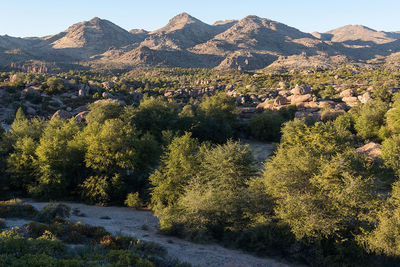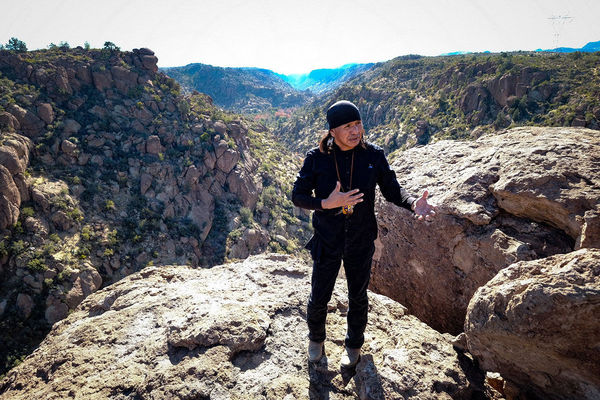Notre Dame Law School Religious Liberty Initiative files amicus brief in support of Apache Stronghold in Oak Flat litigation

The Notre Dame Law School Religious Liberty Initiative has filed an amicus brief in the United States District Court in the case Apache Stronghold vs. United States of America. The brief argues in favor of religious liberty protections for Oak Flat, an Indigenous sacred site in Arizona being threatened with destruction.
The brief was filed by Notre Dame Law Professor Stephanie Barclay, a First Amendment scholar who directs the Law School’s Religious Liberty Initiative, along with the Religious Liberty Initiative’s student cohort. “Our brief highlights a history of callousness and coercion against Indigenous sacred sites like Oak Flat. Our religious freedom laws wouldn’t allow the government to demolish churches with impunity, and the same should be true of a site that has been sacred to the Apache people for generations,” Barclay said. The brief represents Ramon Riley, the White Mountain Apache Tribe Cultural Resource Director, the Morning Star Institute, and the MICA Group (Multicultural Initiative for Community Advancement).
“Notre Dame’s campus is blessed with many sacred places: from the Grotto of Our Lady of Lourdes to the Basilica of the Sacred Heart. But for the Apache people, there is only one Oak Flat,” said Dan Loesing, a 2L student who took a lead role on this brief. “It's an honor to work to protect this historic sacred site and the free exercise rights of those who gather there for prayer and religious ceremonies.”
Apache Stronghold v. United States of America
Click on the link above to read the case documents that Notre Dame Law School’s Religious Liberty Clinic filed in the U.S. Court of Appeals for the Ninth Circuit and the U.S. District Court for the District of Arizona.
In Apache Stronghold vs. United States of America, the District Court of Arizona may decide whether the ramifications of the Resolution Copper project meet the “substantial burden” requirements of the 1993 Religious Freedom Restoration Act. The anticipated physical destruction of Oak Flat will leave an empty crater where religious gatherings and ceremonies once took place. The amicus brief filed by the Notre Dame Law School Religious Liberty Initiative pushes back against arguments by the government that would provide basically no religious freedom protections for Indigenous sacred sites, and that would result in disparate treatment between those sites and other similar types of non-Indigenous religious exercise.
About the Notre Dame Law School Religious Liberty Initiative:
Notre Dame Law School recently launched its Religious Liberty Initiative under the leadership of Stephanie Barclay. The Initiative will involve promoting more religious liberty scholarship, coordinating events for thought leaders in this space, and starting a new Religious Liberty Clinic aimed at promoting religious liberty for people of all faiths. In just the past six months, students in the Religious Liberty Initiative cohort have already helped write briefs filed in the Northern District of New York, the Second Circuit Court of Appeals, and the U.S. Supreme Court, defending the rights of Muslims, Evangelicals, and Orthodox Jews.

Additional Quotes on the Amicus Brief:
The amicus brief was supported by Mona Polacca, President of the International Council of the Thirteen Indigenous Grandmothers. She stated, “The Oak Flat Stronghold is not just a place, but a home to spiritual powers. ... For centuries, Oak Flat has remained an active place where Indigenous people come to pray, harvest, and gather where holy beings reside and holy springs flow. The San Carlos Apache cannot have this spiritual connection with the land anywhere else on Earth.”
Alexandra Howell is a third-year law student at Notre Dame who also helped with the brief, and she explained, “While what is sacred to majority culture and religion is generally safe from government interference, minority religious groups do not have this same guarantee. Our amicus brief made me think about how the Apache burial site located at Oak Flat is akin to Arlington National Cemetery in Washington, D.C. This section of the brief is a crucial reminder of how easy it is to disregard the need for others’ beliefs to receive protection when they look different from our own.”
Ramon Riley, a respected Apache elder, has spent the last two decades working to defend Oak Flat. He opposes the proposed mining project for Oak Flat, because he believes it is wrong to “destroy sacred land that made us who we are.”
The troubling pattern of lack of protection for Indigenous sacred sites is something of particular interest to Professor Barclay. Together with co-author Professor Michalyn Steele, Barclay just published a Harvard Law Review article that argued Indigenous people should be able to more easily make a claim of a substantial burden under RFRA in order to correct certain inequalities in the law. “Allowing Indigenous peoples to demonstrate a substantial burden on the same basis as other religious groups does not guarantee that they will always win their case. Rather, it simply requires government to actually justify its actions, and it incentivizes government to be more protective of sacred sites if it can be," the article argues.
“We are so grateful and honored that Notre Dame is helping the Apache in our time of greatest need," said Apache Stronghold leader and former San Carlos Apache Tribal Chairman Dr. Wendsler Nosie, Sr. "The government is saying that destruction of Chi'chil Bildagoteel will not be a serious problem for us when its destruction will force us to stop practicing our religion.”
“We are grateful that Notre Dame’s Religious Liberty Initiative represented our organization and made it possible for more voices of Indigenous peoples be heard by the court,” said Peggy Mainor, J.D., the Executive Director of the MICA Group. “The brief they wrote has an incredible amount of heart and soul juxtaposed with sharp legal insights.”
The photo at the top of this page is by Elias Butler.